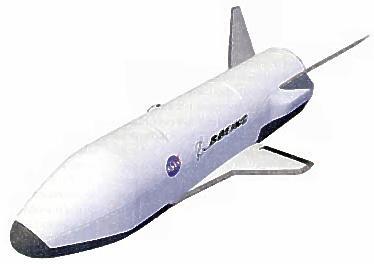
Home - Search - Browse - Alphabetic Index: 0- 1- 2- 3- 4- 5- 6- 7- 8- 9
A- B- C- D- E- F- G- H- I- J- K- L- M- N- O- P- Q- R- S- T- U- V- W- X- Y- Z
X-37

X-37
Credit: NASA
AKA: OTV. Status: Operational 2010. First Launch: 2010-04-22. Last Launch: 2015-05-20. Number: 4 . Gross mass: 3,200 kg (7,000 lb). Height: 8.38 m (27.49 ft). Span: 4.57 m (14.99 ft).
The X-37 Approach and Landing Test Vehicle (ALTV) was an experimental autonomous vehicle designed to demonstrate advanced space flight technologies. Drop tests of the X-37 ALTV were to be conducted at NASA's Dryden Flight Research Center, located at Edwards Air Force Base in California. The ALTV would be dropped five times from NASA's B-52H aircraft from approximately 12 km. Flight research objectives included verification of autonomous landing, demonstration of integrated vehicle and range operation through a Flight Operations Control Center (FOCC), verification of predicted stability and aerodynamic control effectiveness, and verification of ability to conduct flight operations for various wind speeds and different entry azimuths.
The forerunner of the X-37 ALTV, the X-40A, successfully completed a series of seven approach and landing tests at NASA Dryden in 2000 and 2001. About 20 percent smaller than the X-37, the X-40A was released from a helicopter at 4600 m during the series of unpowered glide flights. These flights validated the autonomous flight control system planned for the X-37, thereby reducing the risk of the X-37 program.
The vehicle was assembled at Boeing's High Desert Assembly, Integration and Test Facility in Palmdale, California. NASA's Marshall Space Flight Center in Huntsville, Ala., managed the X-37 program. NASA Dryden was responsible for the X-37 flight activities.
More at: X-37.
| X-40 American unmanned spaceplane. Boeing X-40A Experimental Space Maneuver Vehicle was built to test landing technologies for the later X-37. |
Family: Spaceplane, Suborbital, Technology, US Rocketplanes. Country: USA. Engines: R-4D. Launch Vehicles: Atlas V, Atlas V 501. Launch Sites: Cape Canaveral LC40, Cape Canaveral LC41. Agency: Boeing. Bibliography: 7035, 13354.
 | USA 212 Credit: Manufacturer Image |
 | X-37 Credit: Manufacturer Image |
 | X-37 Credit: Manufacturer Image |
2010 April 22 - . 23:52 GMT - . Launch Site: Cape Canaveral. Launch Complex: Cape Canaveral LC41. Launch Pad: SLC41. LV Family: Atlas V. Launch Vehicle: Atlas V 501.
- USA 212 - . Payload: X-37B OTV 1. Mass: 5,000 kg (11,000 lb). Nation: USA. Agency: Martin. Class: Manned. Type: Manned spaceplane. Spacecraft: X-37. Duration: 224.39 days. USAF Sat Cat: 36514 . COSPAR: 2010-015A. Reusable unmanned military orbital spaceplane. Landed successfully at Vandenberg at 09:16 GMT on 3 December..
2011 March 5 - . 22:46 GMT - . Launch Site: Cape Canaveral. Launch Complex: Cape Canaveral LC41. Launch Pad: SLC41. LV Family: Atlas V. Launch Vehicle: Atlas V 501.
- USA 226 - .
Payload: OTV-2 F1. Mass: 5,000 kg (11,000 lb). Nation: USA.
Class: Manned.
Type: Manned spaceplane. Spacecraft: X-37.
USAF Sat Cat: 37375 . COSPAR: 2011-010A.
Second unmanned Orbital Test Vehicle X-37B reusable spaceplane. Possibly placed in a 400 x 420 km x 40 deg orbit like that used by OTV-1; mission expected to last 9 months with automatic landing at Vandenberg Air Force Base. The Centaur AV-026 upper stage was deorbited over the Indian Ocean on the first orbit.
2012 December 11 - . 18:03 GMT - . Launch Site: Cape Canaveral. Launch Complex: Cape Canaveral LC41. Launch Pad: SLC41. LV Family: Atlas V. Launch Vehicle: Atlas V 501.
- USA 240 - . Payload: X-37B OTV-3. Mass: 5,400 kg (11,900 lb). Nation: USA. Class: Manned. Type: Manned spaceplane. Spacecraft: X-37. USAF Sat Cat: 39025 . COSPAR: 2012-071A. Apogee: 360 km (220 mi). Perigee: 343 km (213 mi). Inclination: 43.50 deg. X-37B flight vehicle 1 completed its second flight on Oct 17 2014, landing at Vandenberg AFB at 16:24 GMT after 674.9 days in space..
2015 May 20 - . 15:05 GMT - . Launch Site: Cape Canaveral. Launch Complex: Cape Canaveral LC40. Launch Pad: Cape Canaveral SLC40. LV Family: Atlas V. Launch Vehicle: Atlas V 501.
- USA 261 - .
Payload: X-37B OTV-4. Mass: 5,400 kg (11,900 lb). Nation: USA.
Class: Technology.
Type: Technology satellite. Spacecraft: X-37.
USAF Sat Cat: 40651 . COSPAR: 2015-025A. Apogee: 332 km (206 mi). Perigee: 309 km (192 mi). Inclination: 38.00 deg.
Classified mission of the winged, recoverable X-37B Orbital Test Vehicle. Publicly stated to be carrying an AFRL ion engine test and a NASA materials exposure experiment. After releasing the X-37B the Centaur AV-054 rocket stage reignited to reach a 355 km x 700 km x 55-57 deg orbit and at around 17:00 GMT released a set of 9 cubesats. Centaur then made a third burn to deorbit itself over the Indian Ocean.
Back to top of page
Home - Search - Browse - Alphabetic Index: 0- 1- 2- 3- 4- 5- 6- 7- 8- 9
A- B- C- D- E- F- G- H- I- J- K- L- M- N- O- P- Q- R- S- T- U- V- W- X- Y- Z
© 1997-2019 Mark Wade - Contact
© / Conditions for Use